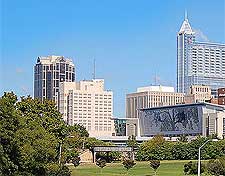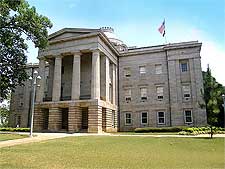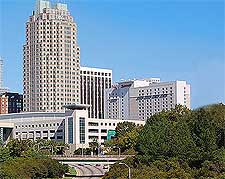Raleigh History Facts and Timeline
(Raleigh, North Carolina - NC, USA)

From the beginning, Raleigh was destined to be the state capital of North Carolina. Purpose-built from its inception to serve as a capital, Raleigh has gone on to prosper as an important socially and racially integrated city, with a good balance of business, higher education and local society.
As one of the three cities within North Carolina's Research Triangle Park, Raleigh has an economy that is fuelled by both its high-tech industries and its political clout.
A Purpose-built State Capital
The history of Raleigh began during the American Revolutionary War, when British troops laid siege to North Carolina's former capital, New Bern. In order for the state to continue governing, it was decided that its capital would be moved inland in 1792, to the site where Raleigh now stands. This was one of the only cities in America to be deliberately established as a capital, laid out in a classic grid pattern with a central square.

Business as Usual
It has always been about business and governance in Raleigh. The city is still the state capital of North Carolina and its Greek-Revival State Capital Building remains the seat of the governor, with this palatial landmark being constructed between the years of 1833 and 1840. As often happens in capital cities, prosperity came easy. The 1800s were a time of major development in Raleigh, with beautiful homes and public buildings erected, and a basic infrastructure quickly established. The historic Oakwood district still looks much as it did 150 years ago.
Fortunately, Raleigh did not suffer much damage during the Civil War, which is why so much of its historic downtown district is intact. After the Civil War, the city moved towards African-American integration and increased tobacco production. Although it was still a relatively small city in the late 1800s, the railroad and tobacco helped to fuel its growth.

Education and Research History
When the Research Triangle Park was opened in 1959, Raleigh's population saw a mild explosion. The many universities based around Raleigh institutions such as the North Carolina State, Wake Forest and Meredith College, have been centers of higher education since the end of the Civil War. The city is home to two especially historic colleges, Shaw University and St. Augustine's College, which were established in 1865 explicitly to educate freed slaves.
This academic environment encouraged the research sector to put down roots in the area, with a number of important companies setting up their facilities and headquarters in the Research Triangle Park that encompasses Raleigh,
Durham and Chapel Hill.
Research continues to be a big part of the local economy, although the city itself is well-rounded with a solid range of cultural and social amenities.
 From the beginning, Raleigh was destined to be the state capital of North Carolina. Purpose-built from its inception to serve as a capital, Raleigh has gone on to prosper as an important socially and racially integrated city, with a good balance of business, higher education and local society.
From the beginning, Raleigh was destined to be the state capital of North Carolina. Purpose-built from its inception to serve as a capital, Raleigh has gone on to prosper as an important socially and racially integrated city, with a good balance of business, higher education and local society.
